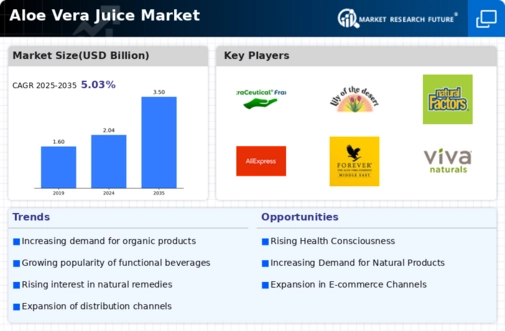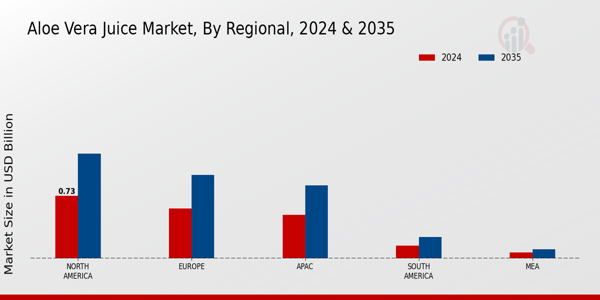Market Growth Projections
The Global Aloe Vera Juice Market Industry is projected to experience substantial growth in the coming years. With a market value of 2.04 USD Billion in 2024, the industry is poised for expansion, potentially reaching 3.5 USD Billion by 2035. This growth trajectory suggests a compound annual growth rate of 5.03% from 2025 to 2035. Such projections indicate a robust demand for aloe vera juice, driven by various factors including health trends, product innovations, and increased consumer awareness. The market's evolution reflects a broader shift towards natural and health-oriented products, positioning aloe vera juice as a key player in the beverage sector.
Rising Health Consciousness
The increasing awareness regarding health and wellness among consumers appears to be a primary driver for the Global Aloe Vera Juice Market Industry. As individuals seek natural and organic products, the demand for aloe vera juice, known for its potential health benefits, is likely to rise. This trend is evidenced by the projected market value of 2.04 USD Billion in 2024, reflecting a growing preference for functional beverages. Consumers are increasingly turning to aloe vera juice for its purported digestive and skin health benefits, which may further bolster its market presence. This shift towards healthier lifestyles indicates a promising trajectory for the industry.
Innovations in Product Offerings
Innovations in product offerings are driving the Global Aloe Vera Juice Market Industry forward. Manufacturers are increasingly introducing new flavors, blends, and formulations to cater to diverse consumer preferences. For instance, the incorporation of aloe vera juice into smoothies, health shots, and functional beverages is gaining traction. Such innovations not only enhance the product's appeal but also expand its market reach. Additionally, the development of fortified aloe vera juices with added vitamins and minerals may attract health-conscious consumers seeking enhanced nutritional benefits. This continuous evolution in product offerings is likely to contribute to the overall growth of the market.
Expansion of Distribution Channels
The expansion of distribution channels plays a crucial role in the growth of the Global Aloe Vera Juice Market Industry. Retailers are increasingly recognizing the potential of aloe vera products, leading to their availability in supermarkets, health food stores, and online platforms. This diversification in distribution not only enhances accessibility for consumers but also encourages impulse purchases. The rise of e-commerce has particularly transformed the landscape, allowing consumers to conveniently purchase aloe vera juice from the comfort of their homes. As a result, the market is expected to witness a significant increase in sales, contributing to the anticipated growth to 3.5 USD Billion by 2035.
Growing Demand for Natural Ingredients
The growing demand for natural ingredients in food and beverages is a notable driver for the Global Aloe Vera Juice Market Industry. Consumers are increasingly inclined towards products that are free from artificial additives and preservatives. Aloe vera juice, often marketed as a natural and healthy option, aligns well with this consumer preference. This trend is likely to be reflected in the market's growth, as the industry adapts to meet the rising expectations for clean-label products. The emphasis on transparency and sustainability in sourcing ingredients may further enhance the appeal of aloe vera juice, potentially leading to a compound annual growth rate of 5.03% from 2025 to 2035.
Increased Awareness of Aloe Vera Benefits
Increased awareness of the health benefits associated with aloe vera is a significant driver for the Global Aloe Vera Juice Market Industry. Educational campaigns and social media influence have played a pivotal role in disseminating information about the potential advantages of aloe vera juice, such as its anti-inflammatory and antioxidant properties. As consumers become more informed, the demand for aloe vera juice is expected to rise, further solidifying its market position. This heightened awareness may also lead to increased consumption rates, thereby contributing to the projected market growth and the anticipated value of 3.5 USD Billion by 2035.





















